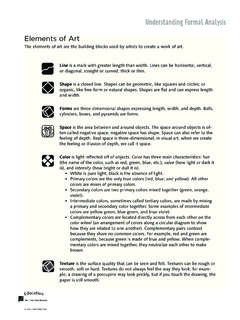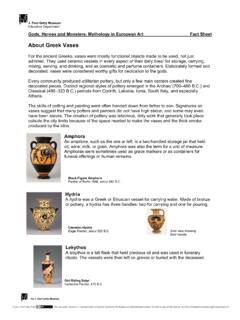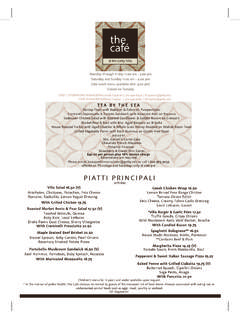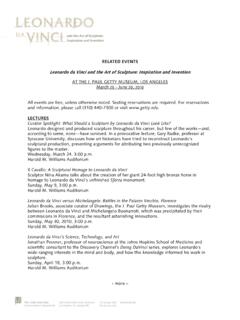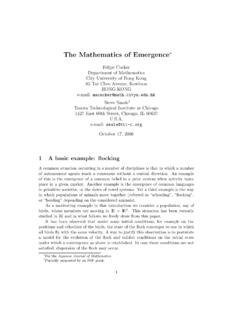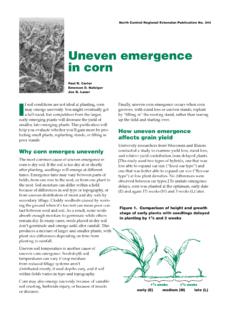Transcription of Emergence, Bill Viola - getty.edu
1 J. Paul getty Museum Education Department Who's Afraid of Contemporary Art? Information and Questions for Teaching emergence , bill Viola 2008 J. Paul getty Trust emergence bill Viola American, 2002 Color high-definition video (rear projection on screen mounted on wall in dark room) Projected image size: 84 5/16 x 84 5/16 x 3 7/8 in. Room dimensions variable Running time: 11:49 minutes Edition 1 of 3 78 x 78 in. Questions for Teaching Describe each figure in this video installation. (Show students the still photos available on the getty Museum's online exhibition bill Viola : The Passions at: ) Think about clothing, hand gestures, how the figures move their bodies, and range of facial expressions.
2 What relationships do you notice between the characters? Who do you think the women in the video represent? Are they aware of each other? How does the young man relate to the two women? Which character do you identify with most closely? Why? Describe the story the artist is communicating in this work. How do the background and the props add to the story? Read the information in the Background Information below. (If you are able to visit the getty Museum, check to see if it's on display so you can view the video in its entirety.) Based on this information, how does this video compare and contrast with movies you see in theaters? bill Viola wants to emphasize the emotional response of the people within his video art object, as well as provoke an emotional response from viewers of the artwork.
3 How does seeing the stills from the video make you feel? Viola slows down the playback speed of the video to force the viewer to pay attention to the subtleties of the characters expressions, poses and gestures. He also wants his video to be a different experience than going to see a movie. How do you think slowing down the speed of a film would change your perception of it? Viola chose not to include sound in the video. How do you think the silence in a video affects a viewer s experience of the video? Do you think emergence would have been more or less effective if the artist used sound to help convey emotions? Why or why not? bill Viola This work was commissioned by the J. Paul getty Museum, Los Angeles Who's Afraid of Contemporary Art?
4 Information and Questions for Teaching emergence , bill Viola 2 2008 J. Paul getty Trust Background Information In the publication bill Viola : The Passions, the artist describes the plot of his video emergence : Two women are seen sitting on either side of a marble cistern in a small courtyard. They wait patiently in silence, only occasionally acknowledging each other's presence. Time becomes suspended and indeterminate, the purpose and destination of their actions unknown. Their vigil is suddenly interrupted by a premonition. The younger woman abruptly turns and stares at the cistern. She watches in disbelief as a young man's head appears, and then his body rises up, spilling water over the sides and out onto the base and the courtyard floor.
5 The cascading water catches the older woman's attention, and she turns to witness the miraculous event. She stands up, drawn by the young man's rising presence. The younger woman grasps his arm and caresses it as if greeting a lost lover. When the young man's pale body reaches its fullest extension, he totters and falls. The older woman catches him in her arms, and with the help of the younger woman, they struggle to lower him gently to the ground. Lying prone and lifeless, he is covered by a cloth. Cradling his head on her knees, the older woman finally breaks down in tears as the younger woman, overcome with emotion, tenderly embraces his body. As a work of art, emergence transcends this and probably any literal description.
6 The video resembles a painting because it is framed, mounted into a wall, silent, and the narrative occurs in extremely slow motion. As a rear-projection installation, it assumes an otherworldly glow. Although the plot suggests biblical stories such as Christ's Resurrection, such metaphorical associations are ambiguous: For example, the man rising out of a fountain of water implies birth, but his body, when laid out on the ground, suggests death. bill Viola created emergence as a work in a series of video pieces he called The Passions. The series was inspired by Viola s participation in the 1998 getty Research Institute guest scholar program. Viola spent a year collaborating with artists and scholars to explore the theme of The Representation of the Passions.
7 Viola wondered how to create a series of video work that explored the expression of emotion the kinds of extreme emotion that cause people to lose control. He was also interested in delving into the worlds of feeling and memory, concentrating on the processes of life, growth, and death that are universally experienced in human existence. Viola was moved by the kinds of emotion he observed in Christian devotional art of the 14th and 15th centuries. emergence was inspired in part by Viola s interaction with a fresco painting of the Piet by the15th-century Italian artist Masolino, which depicts Christ in a sarcophagus, being supported on either side by his mourning mother and St. John. Viola sketched the image and put it away.
8 He is not interested in restaging historical paintings; instead, Viola seeks to bring something new and unfamiliar to the imagery. His original idea conceived of two women pulling a dead man out of a well, but his idea evolved to include the idea of birth as well as death. His original idea was reconceived to present the man s body rising up out of the well, bringing an unexplained surge of water with it, adding contradictory ideas: Was the man drowned? Is it the amniotic fluid of his birth? Viola explains, To our contemporary eyes, it s a drowning; in my inner eye, midwifery. Images like these have a life of their own because they are untethered and free flowing. The video represents opposing ways to read the element of water giving life as Who's Afraid of Contemporary Art?
9 Information and Questions for Teaching emergence , bill Viola 3 2008 J. Paul getty Trust well as taking it away suggesting we as viewers can reexamine and recognize the diversity of associations existing within all of our experiences. To actualize emergence and other works in his series The Passions, Viola had to rethink how he created his video art. He began by creating a storyboard for the video. His methods required him to work like a large-scale movie production, hiring actors, cinematographers, producers, and learning to act as his own director. Viola worked with the actors to create the emotions depicted within the video. He gave them acting scenes to practice their emotions, oftentimes filming them while they performed their acting exercises.
10 emergence employs actors working in a scene, displaying a set of manufactured emotions. This is similar to cinema, where the viewer s feelings are manipulated through the display of artificial emotions. The question becomes one of reality versus artifice what we see on the screen is not necessarily a real story, but remains connected to the viewer s own perceptions and personal experiences. Viola slowed down the real-time of the video, allowing the viewer to carefully scrutinize each of the actors and the emotions they portray. Many of Viola s works attempt to engage the viewer with strong emotion that can be interpreted based on personal experience and response. By slowing down time, Viola creates a different experience than our typical encounter with film and focuses our attention on the deliberate intent of the actors within the video.


